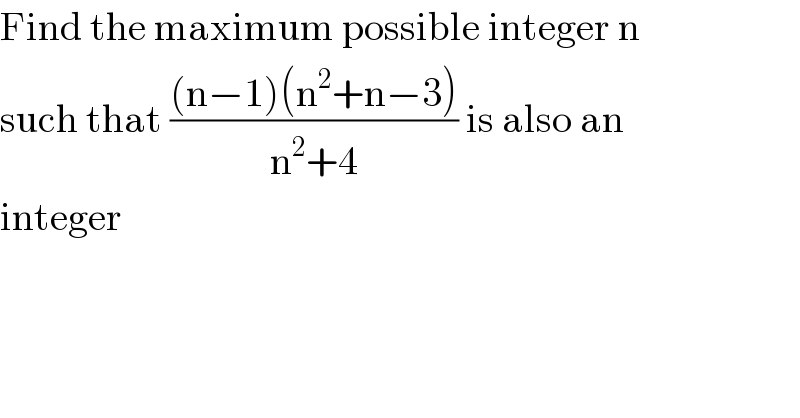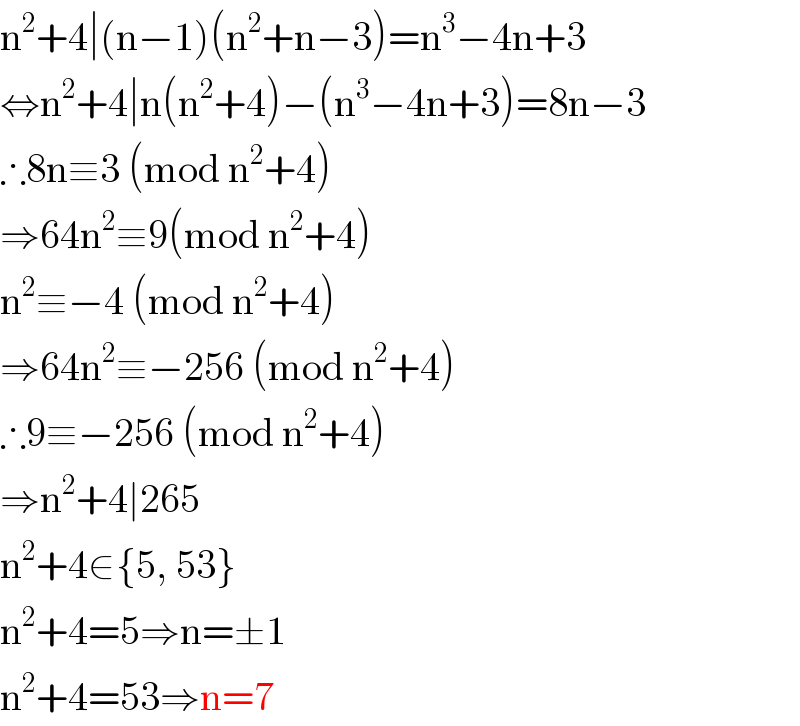
Question Number 110593 by Aina Samuel Temidayo last updated on 29/Aug/20

$$\mathrm{Find}\:\mathrm{the}\:\mathrm{maximum}\:\mathrm{possible}\:\mathrm{integer}\:\mathrm{n} \\ $$$$\mathrm{such}\:\mathrm{that}\:\frac{\left(\mathrm{n}−\mathrm{1}\right)\left(\mathrm{n}^{\mathrm{2}} +\mathrm{n}−\mathrm{3}\right)}{\mathrm{n}^{\mathrm{2}} +\mathrm{4}}\:\mathrm{is}\:\mathrm{also}\:\mathrm{an} \\ $$$$\mathrm{integer} \\ $$
Answered by floor(10²Eta[1]) last updated on 19/Oct/20

$$\mathrm{n}^{\mathrm{2}} +\mathrm{4}\mid\left(\mathrm{n}−\mathrm{1}\right)\left(\mathrm{n}^{\mathrm{2}} +\mathrm{n}−\mathrm{3}\right)=\mathrm{n}^{\mathrm{3}} −\mathrm{4n}+\mathrm{3} \\ $$$$\Leftrightarrow\mathrm{n}^{\mathrm{2}} +\mathrm{4}\mid\mathrm{n}\left(\mathrm{n}^{\mathrm{2}} +\mathrm{4}\right)−\left(\mathrm{n}^{\mathrm{3}} −\mathrm{4n}+\mathrm{3}\right)=\mathrm{8n}−\mathrm{3} \\ $$$$\therefore\mathrm{8n}\equiv\mathrm{3}\:\left(\mathrm{mod}\:\mathrm{n}^{\mathrm{2}} +\mathrm{4}\right) \\ $$$$\Rightarrow\mathrm{64n}^{\mathrm{2}} \equiv\mathrm{9}\left(\mathrm{mod}\:\mathrm{n}^{\mathrm{2}} +\mathrm{4}\right) \\ $$$$\mathrm{n}^{\mathrm{2}} \equiv−\mathrm{4}\:\left(\mathrm{mod}\:\mathrm{n}^{\mathrm{2}} +\mathrm{4}\right) \\ $$$$\Rightarrow\mathrm{64n}^{\mathrm{2}} \equiv−\mathrm{256}\:\left(\mathrm{mod}\:\mathrm{n}^{\mathrm{2}} +\mathrm{4}\right) \\ $$$$\therefore\mathrm{9}\equiv−\mathrm{256}\:\left(\mathrm{mod}\:\mathrm{n}^{\mathrm{2}} +\mathrm{4}\right) \\ $$$$\Rightarrow\mathrm{n}^{\mathrm{2}} +\mathrm{4}\mid\mathrm{265} \\ $$$$\mathrm{n}^{\mathrm{2}} +\mathrm{4}\in\left\{\mathrm{5},\:\mathrm{53}\right\} \\ $$$$\mathrm{n}^{\mathrm{2}} +\mathrm{4}=\mathrm{5}\Rightarrow\mathrm{n}=\pm\mathrm{1} \\ $$$$\mathrm{n}^{\mathrm{2}} +\mathrm{4}=\mathrm{53}\Rightarrow\mathrm{n}=\mathrm{7} \\ $$
Commented by Aina Samuel Temidayo last updated on 30/Aug/20

$$\mathrm{I}\:\mathrm{see}.\:\mathrm{You}'\mathrm{ve}\:\mathrm{corrected}\:\mathrm{your}\:\mathrm{mistake}. \\ $$
Commented by Aina Samuel Temidayo last updated on 30/Aug/20

$$\mathrm{Thanks}. \\ $$
